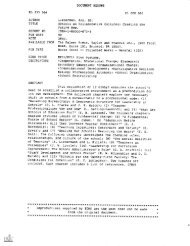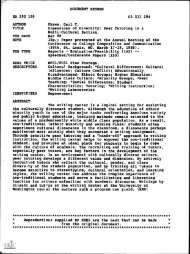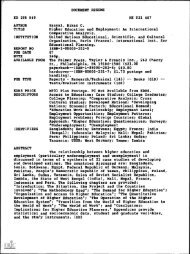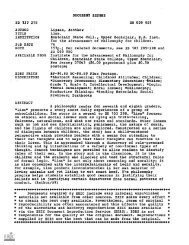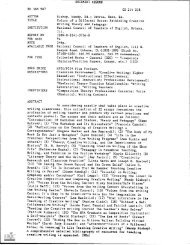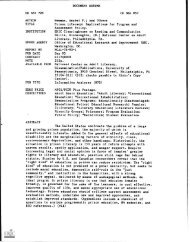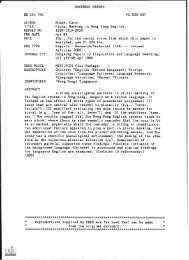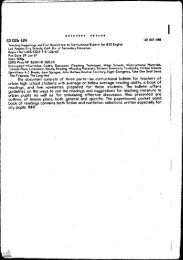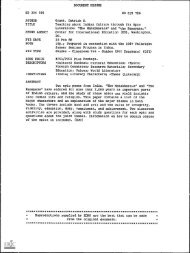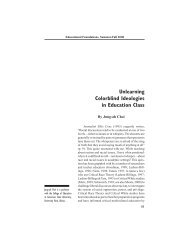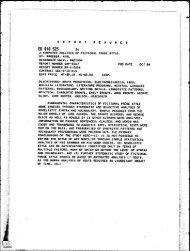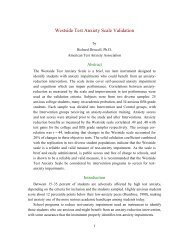- Page 1 and 2: DOCUMENT RESUMEED 270 509 UD 024 85
- Page 3 and 4: AzMR emurneeNT 101WATIONOleos et Ed
- Page 5 and 6: The Center for Migration Studies is
- Page 7 and 8: viTHE HMONG IN TRANSITIONTHE MIAO I
- Page 9 and 10: viiiTHE HMONG IN TRANSITIONA NOTE O
- Page 11 and 12: xTABLE OF CONTENTSSudden Deaths of
- Page 13 and 14: x11THE HMONG IN TRANSITIONpapers pr
- Page 15 and 16: \ \ Sichuan / d\ I /Guizhou ' ) Ir
- Page 17: INTRODUCTIONGLENN L. HENDRICKSA com
- Page 21 and 22: 8 THE HMONG IN TRANSITION2. Laos tr
- Page 23 and 24: 10 THE HMONG IN TRANSITIONPlais. Th
- Page 25 and 26: 12 THE HMONG IN TRANSITIONmixture o
- Page 27 and 28: 2614 THE HMONG IN TRANSITIONtion of
- Page 29 and 30: 16 THE HMONG IM TRANSITIONto their
- Page 31 and 32: 18 THE HMONG IN TRANSITIONinvented
- Page 33 and 34: 20 THE HMONG IN TRANSITION5Note tha
- Page 35 and 36: 22 THE HMONG IN TRANSITIONStudy Sit
- Page 37 and 38: 24 THE HMONG IN TRANSIT1011Table 1V
- Page 39 and 40: Table 2ARRIVALS IN THAILAND BY YEAR
- Page 41 and 42: 78THE HMONG IN TRANSITIONwith the F
- Page 43 and 44: 30 THE HMONG IN TRANSITIONat the sa
- Page 45 and 46: 32 THE HMONG IN TRANSITIONsides and
- Page 47 and 48: 34 THE HMONG IN TRANSITIONture but
- Page 49 and 50: 36 THE HMONG IN TRANSITIONuse the r
- Page 51 and 52: 38 THE HMONG IN TRANSITION8. Depart
- Page 53 and 54: 40 THE MOM III TRANSITIONviding liv
- Page 55 and 56: 42 THE HMONG IN TRANSITIONthere hav
- Page 57 and 58: 44 THE HMONG IN TRANSITIONpromoted
- Page 59 and 60: 46 THE HMONG IN TRANSITIONabout the
- Page 61 and 62: 48 THE HMONG IN TRANSITIONBuddhist
- Page 63 and 64: 50 THE HMONG IN TRANSITIONtimes hos
- Page 65 and 66: 52 THE HMONG IN TRANSITION2The pref
- Page 67 and 68: CULTURE AND ADAPTATION:HMONG REFUGE
- Page 69 and 70:
CULTURE AND ADAPTATION: HMONG REFUG
- Page 71 and 72:
CULTURE AND ADAPTATION: HMONG REFUG
- Page 73 and 74:
CULTURE AND ADAPTATION: HMONG REFUG
- Page 75 and 76:
CULTURE AND ADAPTATION: HMONG REFUG
- Page 77 and 78:
CULTURE AND ADAPTATION: HMONG REFUG
- Page 79 and 80:
CULTURE AND ADAPTATION: HMONG REFUG
- Page 81 and 82:
CULTURE AND ADAPTATION: HMONG REFUG
- Page 83 and 84:
CULTURE AND ADAPTATION: HMONG REFUG
- Page 85 and 86:
74 THE HMONG IN TRANSITIONauspices
- Page 87 and 88:
76 THE HMONG IN TRANSITIONeven the
- Page 89 and 90:
8878 THE HMONG IN TRANSITIONtively
- Page 91 and 92:
80 THE HMONG IN TRANSITIONGuizhou,
- Page 93 and 94:
82 THE HMONG IN TRANSITIONhero from
- Page 95 and 96:
84 THE HMONG IN TRANSITIONHmong ter
- Page 97 and 98:
GEOMANCY AS AN ASPECTOF UPI. AND-LO
- Page 99 and 100:
GEOMANCY AS AN ASPECT OF RELATIONSH
- Page 101 and 102:
GEOMANCY AS AN ASPECT OF RELATIONSH
- Page 103 and 104:
GEOMANCY AS AN ASPECT OF RELATIONSH
- Page 105 and 106:
GEOMANCY AS AN ASPECT OF RELATIONSH
- Page 107 and 108:
INTRODUCTIONGlenn L. HendricksIn th
- Page 109 and 110:
TRAINING HMONG WOMEN: FOR MARGINAL
- Page 111 and 112:
TRAINING HMONG WOMEN FOR MARGINAL W
- Page 113 and 114:
TRAINING HMONG WOMEN FOR MARGINAL W
- Page 115 and 116:
TRAINING HMONG WOMEN FOR MARGINAL W
- Page 117 and 118:
TRAINING HMONG WOMEN FOR MARGINAL W
- Page 119 and 120:
TRAINING HMONG WOMEN FOR MARGINAL W
- Page 121 and 122:
TRAINING HMONG WOMEN FOR MARGINAL W
- Page 123 and 124:
TRAINING HMONG WOMEN FOR MARGINAL W
- Page 125 and 126:
TRAINING HMONG WOMEN FOR MARGINAL W
- Page 127 and 128:
DataTRAINING HMONG WOMEN FOR MARGIN
- Page 129 and 130:
CHANGES IN HMONG REFUGEE MARITALATT
- Page 131 and 132:
CHANGES IN HMONG REFUGEE IN AMERICA
- Page 133 and 134:
CHANGES IN HMONG MARITAL ATTITUDES
- Page 135 and 136:
1CHANGES IN HMONG MARITAL ATTITUDES
- Page 137 and 138:
CHANGES IN HMCNG REFUGEE ATTITUDES
- Page 139 and 140:
CHANGES IN HMONG MARITAL ATTITUDES
- Page 141 and 142:
CHANGES IN HMONG MARITAL ATTITUDES
- Page 143 and 144:
136 THE HMONG IN TRANSITIONhave bee
- Page 145 and 146:
138 THE HMONG IN TRANSITIONcharge o
- Page 147 and 148:
140 THE HMONG IN TRANSITIONShe woul
- Page 149 and 150:
142 THE HMONG IN TRANSITIONmarily w
- Page 151 and 152:
THE HMONG IN ISLA VISTA:OBSTACLES A
- Page 153 and 154:
THE HMONG IN ISLA VISTA 147view." T
- Page 155 and 156:
THE HMONG IN ISLA VISTA 149one such
- Page 157 and 158:
THE HMONG IN ISLA VISTA 151differen
- Page 159 and 160:
THE HMONG IN ISLA VISTA 153voluntee
- Page 161 and 162:
THE HMONG IN ISLA VISTA155Other suc
- Page 163 and 164:
THE HMONG IN ISLA VISTA 157Trillin,
- Page 165 and 166:
FACTORS CONTRIBUTING TO A SPLIT WIT
- Page 167 and 168:
'166NEEDLEWORK COOPERATIVE 161feren
- Page 169 and 170:
NEEDLEWORK COOPERATIVE 163ciety; fo
- Page 171 and 172:
NEEDLEWORK COOPERATIVE 165Where a b
- Page 173 and 174:
NEEDLEWORK COOPERATIVE167Figure 2ST
- Page 175 and 176:
NEEDLEWORK COOPERA fIVE 169to consi
- Page 177 and 178:
NEEDLEWORK COOPERATIVE 171ing quest
- Page 179 and 180:
NEEDLEWORK COOPERATIVE 173edited by
- Page 181 and 182:
176 THE HMONG IN TRANSITION- How ar
- Page 183 and 184:
178 THE HMONG IN TRANSITIONFinal Re
- Page 185 and 186:
184180 THE HMONG IN TRANSITIONTable
- Page 187 and 188:
182 THE HMONG IN TRANSIT:ONnatural
- Page 189 and 190:
184 THE HMONG IN TRANSITIONfamily c
- Page 191 and 192:
186 THE HMONG IN TRANSITIONb) The d
- Page 193 and 194:
188 THE HMONG IN TRANSITIONjob-trai
- Page 195 and 196:
190 THE HMONG IN TRANSITIONFifty-fi
- Page 197 and 198:
192 THE HMONG IN TRANSITIONis no po
- Page 199 and 200:
194 THE HMONG IN TRANSITIONures suc
- Page 201 and 202:
196 THE HMONG IN TRANSITIONWelfare
- Page 203 and 204:
198 THE HMONG IN TRANSITIONcamps. T
- Page 205 and 206:
200 THE HMONG IN TRANSITIONplans, a
- Page 207 and 208:
ECONOMIC DEVELOPMENT AND EMPLOYMENT
- Page 209 and 210:
204 THE HMONG IN TRANSITIONPressure
- Page 211 and 212:
206 THE timoric IN TRANSITIONand fi
- Page 213 and 214:
208 THE HMONG IN TRANSITIONwilling
- Page 215 and 216:
PART THREELanguage and Literacy214
- Page 217 and 218:
214 THE HMONG IN TRANSITIONlike Eng
- Page 219 and 220:
216 THE HMONG IN TRANSITIONvious re
- Page 221 and 222:
218 THE HMONG IN TRANSITION- b high
- Page 223 and 224:
220 THE HMONG IN TRANSITIONwords to
- Page 225 and 226:
222 THE HMONG IN TRANSITIONThis see
- Page 227 and 228:
224 THE HMONG IN TRANSITIONwould be
- Page 229 and 230:
226 THE HMONG IN TRANSITIONtical in
- Page 231 and 232:
228 THE HMOMG IM TRANSITIONzig zuag
- Page 233 and 234:
230 THE HMONG IN TRANSITIONlis loos
- Page 235 and 236:
232 THE HMONG IN TRANSITION+quj gee
- Page 237 and 238:
234 THE HMONG IN TRANSITIONNOTESIDi
- Page 239 and 240:
236 THE HMONG IN TRANSITIONedited b
- Page 241 and 242:
238 THE HMONG IN TRANSITIONduplicat
- Page 243 and 244:
240 THE HMONG IN TRANSITION(8) Kuv
- Page 245 and 246:
242 THE HMONG IN TRANSITION(17) Koj
- Page 247 and 248:
THE MORPHEME KOM: A FIRST ANALYSISA
- Page 249 and 250:
(4) Kuv tsis kom nws mus.I NEG orde
- Page 251 and 252:
THE MORPHEME ROM 249(13) Ku, mus ta
- Page 253 and 254:
(19a) Kuv xav mus.I want go"I want
- Page 255 and 256:
THE MORPHEME KOM 253xovthawbchebtos
- Page 257 and 258:
(29) Kuv nyiam kom sawv daws nyobI
- Page 259 and 260:
THE MORPHEME KOM 257tences introduc
- Page 261 and 262:
THE MORPHEME KOM 259higher verb mea
- Page 263 and 264:
ZERO ANAPHORA AND TOPIC PROMINENCE
- Page 265 and 266:
ZERO ANAPHORA AND TOPIC PROMINENCE
- Page 267 and 268:
ZERO ANAPHORA AND TOPIC PROMINENCE
- Page 269 and 270:
ZERO ANAPHORA AND TOPIC PROMINENCE
- Page 271 and 272:
ZERO ANAPHORA AND TOPIC PROMINENCE
- Page 273 and 274:
ZERO ANAPHORA AND TOPIC PROMINENCE
- Page 275 and 276:
ZERO ANAPHORA AND TOPIC PROMINENCE
- Page 277 and 278:
ZERO ANAPHORA AND TOPIC PROMINENCE
- Page 279 and 280:
ZERO ANAPHORA AND TOPIC PROMINENCE
- Page 281 and 282:
280 THE HMONG IN TRANSITIONThe Hmon
- Page 283 and 284:
282 THE HMONG IN TRANSITIONlooking
- Page 285 and 286:
284 THE HMONG IN TRANSITIONfore, li
- Page 287 and 288:
286 THE HMONG IN TRANSITIONrate wit
- Page 289 and 290:
288 THE HMONG IN TRANSITIONher oven
- Page 291 and 292:
290 THE HMONG IN TRANSITIONparticip
- Page 293 and 294:
292 THE HMONG IN TRANSITIONCenter.
- Page 295 and 296:
294 THE HMONG IN TRANSMONIt remains
- Page 297 and 298:
296 THE HMONG IN TRANSITIONGoody, J
- Page 299 and 300:
FACTORS IN INDIVIDUAL ACQUISITION O
- Page 301 and 302:
FACTORS IN INDIVIDUAL ACQUISITION O
- Page 303 and 304:
FACTORS IN INDIVIDUAL ACQUISITION O
- Page 305 and 306:
FACTORS IN INDIVIDUAL ACQUISITION O
- Page 307 and 308:
307 FACTORS IN INDIVIDUAL ACQUISITI
- Page 309 and 310:
9044424031363432302126V 24H 22u; 20
- Page 311 and 312:
FIGURE 3WRITTEN VOCABULARY RECOGNIT
- Page 313 and 314:
FACTORS IN INDIVIDUAL ACQUISITION O
- Page 315 and 316:
TABUS 2English Proficiency Scores b
- Page 317 and 318:
FACTORS IN INDIVIDUAL ACQUISITION O
- Page 319 and 320:
FACTORS IN INDIVIDUAL ACQUISITION O
- Page 321 and 322:
FACTORS IN INDIVIDUAL ACQUISITION O
- Page 323 and 324:
FACTORS IN INDIVIDUAL ACQUISITION O
- Page 325 and 326:
FACTORS IN INDIVIDUAL ACQUISITION O
- Page 327 and 328:
Pearson Correlations of Scores' by
- Page 329 and 330:
FACTORS IN INDIVIDUAL ACQUISITION O
- Page 331 and 332:
INTRODUCTIONAmos S. DeinardIn an ef
- Page 333 and 334:
INTRODUCTION 335Munger reports on f
- Page 335 and 336:
SHAMANISM IN THE CONTEXT OF HMONG R
- Page 337 and 338:
SHAMANISM IN THE CONTEXT OF HMONG R
- Page 339 and 340:
SHAMANISM IN THE CONTEXT OF HMONG R
- Page 341 and 342:
SHAMANISM IN THE CONTEXT OF HMONG R
- Page 343 and 344:
SHAMANISM IN THE CONTEXT OF HMONG R
- Page 345 and 346:
SHAMANISM IN THE CONTEXT OF HMONG R
- Page 347 and 348:
GUIDELINES FOR MENTAL HEALTH PROFES
- Page 349 and 350:
GUIDELINES FOR MENTAL HEALTH PROFES
- Page 351 and 352:
GUIDELINES FOR MENTAL HEALTH PROFES
- Page 353 and 354:
GUIDELINES FOR MENTAL HEALTH PROFES
- Page 355 and 356:
GUIDELINES FOR MENTAL HEALTH PROFES
- Page 357 and 358:
GUIDELINES FOR MENTAL HEALTH PROFES
- Page 359 and 360:
GUIDELINES FOR MENTAL HEALTH PROFES
- Page 361 and 362:
GUIDELINES FOR MENTAL HEALTH PROFES
- Page 363 and 364:
366 THE HMONG IN TRANSITIONHMONG SH
- Page 365 and 366:
368 THE HMONG IN TRANSITIONChildren
- Page 367 and 368:
370 THE HMONG IN TRANSITIONTHE MAND
- Page 369 and 370:
372 THE HMONG IN TRANSITIONoutside,
- Page 371 and 372:
3 0HMONG PERCEPTION OF ILLNESS 374b
- Page 373 and 374:
376 THE HMONG IN TRANSITIONBefore U
- Page 375 and 376:
378 THE HMONG IN TRANSITIONCatanzar
- Page 377 and 378:
380 THE HMONG IN TRANSITIONSudden d
- Page 379 and 380:
33,382 THE HMONG IN TRANISITIONit w
- Page 381 and 382:
384 THE HMONG IN TRANSITIONThe camp
- Page 383 and 384:
386 THE HMONG IN TRANSITIONon secon
- Page 385 and 386:
388 THE HMONG IN TRANSITIONwoman he
- Page 387 and 388:
390 THE HMONG IN TRANSITIONrest of
- Page 389 and 390:
392 THE HMONG IN TRANSITIONin less
- Page 391 and 392:
394 THE HMONG IN TRANSITIONYou want
- Page 393 and 394:
396 THE HMONG IN TRANSITIONand Ms.
- Page 395 and 396:
398 THE HMONG IN TRANSITIONTauxe, R
- Page 397 and 398:
396400 THE HMONG IN TRANSITIONent-c
- Page 399 and 400:
402 THE HMONG IN TRANSITIONwhether
- Page 401 and 402:
404 THE HMONG IN TRANSITIONand chil
- Page 403 and 404:
406 THE HMONG IN TRANSITIONzation o
- Page 405 and 406:
408 THE HMONG IN TRANSITIONHmongCau
- Page 407 and 408:
410 THE HMONG IN TRANSITIONaveraged
- Page 409 and 410:
412 THE HMONG IN TRANSITIONare quit
- Page 411 and 412:
414 THE HMONG IN TRANSITIONCaldwell
- Page 413 and 414:
416 THE HMONG IN TRANSITIONVaughn,
- Page 415 and 416:
418 THE HMONG IN TRANSITIONheadache
- Page 417 and 418:
420 THE HMONG IN TRANSITIONtherapy.
- Page 419 and 420:
422 THE HMONG IN TRANSITIONradiogra
- Page 421 and 422:
424 THE HMONG IN TRANSITIONregard t
- Page 423 and 424:
ATTITUDES OF HMONG TOWARDA MEDICAL
- Page 425 and 426:
424HMONG ATTITUDES TOWARD A MEDICAL
- Page 427 and 428:
HMONG ATTITUDES TOWARD A MEDICAL RE
- Page 429 and 430:
HMONG ATTITUDES TOWARD A MEDICAL RE
- Page 431 and 432:
HMONG ATTITUDES TOWARD A MEDICAL RE
- Page 433 and 434:
HMONG ATTITUDES TOWARD A MEDICAL RE
- Page 435 and 436:
HMONG ATTITUDES TOWARD A MEDICAL RE
- Page 437 and 438:
HMONG ATTITUDES TOWARD A MEDICAL RE
- Page 439 and 440:
HMONG ATTITUDES TOWARD A MEDICAL RE
- Page 441 and 442:
HMONG ATTITUDES TOWARD A MEDICAL RE
- Page 443 and 444:
448 THE HMONG IN TRANSITIONNancy D.
- Page 445 and 446:
450 THE HMONG IN TRANSITIONSouth Wa
- Page 447 and 448:
452 THE HMONG IN TRANSITIONWilliam
- Page 449 and 450:
454 THE HMONG IN TRANSITIONCCSDPT H
- Page 451 and 452:
456 THE HMONG IN TRANSITIONFriends,
- Page 453 and 454:
458 THE HMONG IM TRANSITIONKasl, S
- Page 455 and 456:
460 THE HMONG IN TRANSITIONNational
- Page 457 and 458:
462 THE HMONG IN TRANSITIONSebeok,
- Page 459:
R464 THE HMONG IN TRANSITIONWalker,



